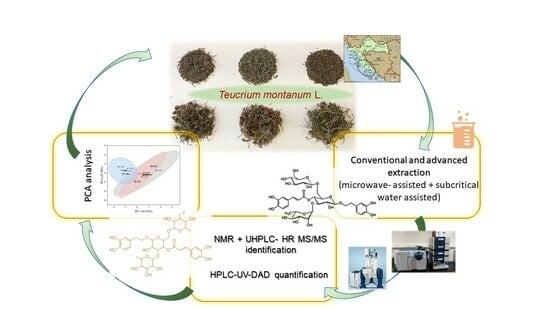Teucrium montanum L.—Unrecognized Source of Phenylethanoid Glycosides: Green Extraction Approach and Elucidation of Phenolic Compounds via NMR and UHPLC-HR MS/MS
Abstract
:1. Introduction
2. Materials and Methods
2.1. Plant Materials
2.2. Chemicals and Reagents
2.3. Methods
2.3.1. Determination of Dry Weight
2.3.2. Preparation of Water Extracts via HAE, MAE, and SWE Technique
2.3.3. Total Phenolic Content (TPC)
2.3.4. Antioxidant Capacity (AC)
2.3.5. Identification and Structure Characterization Using NMR Spectroscopy
Isolation of Dominant Phenylethanoid Glycosides
NMR Spectroscopy
2.3.6. Identification Using HPLC-UV-DAD and UHPLC-HR MS/MS Techniques
Isolation of Polyphenolic Compounds Using Analytical HPLC-UV-DAD
UHPLC-HR MS/MS and HPLC-UV-DAD Analysis
2.3.7. HPLC-UV-DAD Quantification of Identified Polyphenolic Compounds
2.3.8. Statistical Analysis
3. Results and Discussion
3.1. Determination of TPC and AC
3.2. NMR Structure Characterization of Selected PGs
3.3. HPLC-UV-DAD and UHPLC-HR MS/MS Identification
3.3.1. UHPLC-HR MS/MS Identification of PGs
| Fraction | tR of Fraction (min) | Identified Compound | Molecular Formula | Error (ppm) | Calculated Mass (m/z) | Observed Mass [M-H]− (m/z) | MS/MS (m/z) and Abundance of Each Fragment Ion (%) | Reference |
|---|---|---|---|---|---|---|---|---|
| PH1 | 16.93 | vicenin-2 | C27H30O15 | 3.37 | 593.1512 | 593.1532 | MS2 [593.1532]: 353.0669 (100), 383.0773 (60.8), 473.1095 (18.5), 325.0716 (10.9), 413.0876 (6.6), 503.1192 (6.4) | [56] |
| PH2 | 18.25 | β-OH-forsythoside B | C34H44O20 | 3.37 | 771.2353 | 771.2379 | MS2 [771.2379]: 179.0345 (100), 753.2234 (24.7), 661.1967 (5.3), 591.1925 (13.5) | [51] |
| PH4 | 21.47 | jionoside A | C36H48O20 | 3.88 | 799.2666 | 799.2697 | MS2 [799.2697]: 623.2192 (100), 175.0399 (60.9), 477.1604 (5.8), | [52] |
| PH5 | 22.55 | teupolioside | C35H46O20 | 1.53 | 785.2510 | 785.2522 | MS2 [785.2522]: 623.2189 (52.3), 161.0241 (100), 477.1609 (2.61), | [53] |
| PH6 | 22.93 | stachysoside A | C34H44O19 | 1.46 | 755.2404 | 755.2415 | MS2 [755.2415]: 161.0244 (100), 593.2097 (42.2), 461.1660 (14.08), 623.1972 (2.5), 315.1078 (2.6) | [54] |
| PH7 | 23.43 | poliumoside | C35H46O19 | 2.60 | 769.2561 | 769.2581 | MS2 [769.2581]: 161.0244 (100), 607.2240 (35.1), 461.1649 (3.4), | [55] |
| PH9 | 24.59 | forsythoside B | C34H44O19 | 0.66 | 755.2404 | 755.2409 | MS2 [755.2409]: 161.0241 (100), 593.2080 (55.1), 461.1656 (16.4), 623.1980 (6.6), 315.1079 (3.1) | [52] |
| PH10 | 25.07 | isoverbascoside | C29H36O15 | 2.84 | 623.1981 | 623.1999 | MS2 [623.1999]: 161.0249 (100), 113.0242 (16.4), 461.1659 (15.4), 315.1076 (3.4), 251.0551 (1.5) | [51] |
| PH11 | 25.42 | unknown compound | / | / | / | 635.1993 | MS2 [635.1993]: 455.1345 (100), 309.0977 (97.5), 163.0396 (29.5), 187.0395 (29.5) | / |
| PH12 | 26.48 | diosmin | C28H32O15 | 0.00 | 607.1668 | 607.1668 | MS2 [607.1668]: 299.0558 (100), 284.0322 (59.8) | [53] |
| PH13 | 33.02 | acacetin-7-O-rutinoside | C28H32O14 | 3.04 | 591.1719 | 591.1737 | MS2 [591.1737]: 283.0620 (100), 268.0377 (39.0) | [57] |
3.3.2. UHPLC-HR MS/MS Identification of Flavonoid (di)glycosides
3.4. HPLC-UV-DAD Quantification of Identified Polyphenols
3.5. PCA Analysis
4. Conclusions
Supplementary Materials
Author Contributions
Funding
Data Availability Statement
Conflicts of Interest
References
- World Health Organisation. The First WHO Traditional Medicine Global Summit. 2023. Available online: https://www.who.int/news-room/events/detail/2023/08/17/default-calendar/the-first-who-traditional-medicine-global-summit (accessed on 21 September 2023).
- Chavan, S.S.; Damale, M.G.; Shinde, D.B.; Sangshetti, J.N. Antibacterial and antifungal drugs from natural source: A review of clinical development. In Natural Products in Clinical Trials, 1st ed.; Rahman, A., Anjum, S., El Seedi, H., Eds.; Benthan Science Books: Sharjah, United Arab Emirates, 2018; Volume 1, pp. 114–164. ISBN 978-1-68108-213-4. [Google Scholar]
- Pandey, A.; Kumar, S. Perspective on plant products as antimicrobials agents: A review. Pharmacologia 2013, 4, 469–480. [Google Scholar] [CrossRef]
- Luczaj, L.; Jug-Dujaković, M.; Dolina, K.; Jeričević, M.; Vitasović-Kosić, I. Insular pharmacopoeias: Ethnobotanical characteristics of medicinal plants used on the Adriatic islands. Front. Pharmacol. 2021, 7, 623070. [Google Scholar] [CrossRef]
- Özdemir, E.; Alpınar, K. An ethnobotanical survey of medicinal plants in western part of central Taurus Mountains: Aladaglar (Nigde–Turkey). J. Ethnopharmacol. 2015, 166, 53. [Google Scholar] [CrossRef]
- Savić, J.; Mačukanović-Jocić, M.; Jarić, S. Medical ethnobotany on the javor mountain (Bosnia and Herzegovina). Eur. J. Intern. Med. 2019, 27, 52–64. [Google Scholar] [CrossRef]
- Šarić-Kundalić, B.; Fritz, E.; Dobeš, C.; Saukel, J. Traditional medicine in the Pristine Village of Prokoško Lake on Vranica Mountain, Bosnia and Herzegovina. Sci. Pharm. 2010, 78, 75–290. [Google Scholar] [CrossRef]
- Ari, S.; Temel, M.; Kargıoğlu, M.; Konuk, M. Ethnobotanical survey of plants used in Afyonkarahisar–Turkey. J. Ethnobiol. Ethnomed. 2015, 11, 84. [Google Scholar] [CrossRef]
- Fatiha, B.A.; Ouafae, B.; Souad, S.; Fatima, E.H.; Jamila, D.; Allal, D.; Lahcen, Z. Ethnobotany study of medicinal plants used in the treatment of respiratory diseases in the middle region of Oum Rbai. Int. J. Environ. Agric. Biotechnol. 2017, 2, 1460–1468. [Google Scholar] [CrossRef]
- Zlatković, B.; Bogosavljević, S.; Radivojević, A.; Pavlović, M. Traditional use of the native medicinal plant resource of Mt. Rtanj (Eastern Serbia): Ethnobotanical evaluation and comparison. J. Ethnopharmacol. 2014, 151, 704–713. [Google Scholar] [CrossRef]
- Vuković, N.; Milošević, T.; Sukdolak, S.; Solujić, S. Antimicrobial activities of essential oil and methanol extract of Teucrium montanum. Evid. Based Complement. Altern. Med. 2007, 4, 17–20. [Google Scholar] [CrossRef]
- Stanković, M.; Ćurčić, M.; Žižić, J.; Topuzović, M.; Solujić, S.; Marković, S. Teucrium plant species as natural sources of novel anticancer compounds: Antiproliferative, proapoptotic and antioxidant properties. Int. J. Mol. Sci. 2011, 12, 4190–4205. [Google Scholar] [CrossRef]
- Sghaier, M.B.; Harizi, H.; Louhichi, T.; Krifa, M.; Ghedira, K.; Chekir-Ghedira, L. Anti-inflammatory and antiulcerogenic activities of leaf extracts and sesquiterpene from Teucrium ramosissimum (Lamiaceae). Immunopharmacol. Immunot. 2011, 33, 656–662. [Google Scholar] [CrossRef] [PubMed]
- Farahmandfar, R.; Asnaashari, M.; Bakhshandeh, T. Influence of ultrasound-assist and classical extractions on total phenolic, tannin, flavonoids, tocopherol and antioxidant characteristics of Teucrium polium aerial parts. J. Food Meas. Charact. 2019, 13, 1357–1363. [Google Scholar] [CrossRef]
- Bektašević, M.; Jurin, M.; Roje, M.; Politeo, O. Phytochemical profile, antioxidant activity and cholinesterase inhibition potential of essential oil and extracts of Teucrium montanum from Bosnia and Herzegovina. Separations 2023, 10, 421. [Google Scholar] [CrossRef]
- Olcha, P.; Winiarska-Mieczan, A.; Kwiecień, M.; Nowakowski, Ł.; Miturski, A.; Semczuk, A.; Kiczorowska, B.; Gałczyński, K. Antioxidative, anti-inflammatory, anti-obesogenic, and antidiabetic properties of tea polyphenols-the positive impact of regular tea consumption as an element of prophylaxis and pharmacotherapy support in endometrial cancer. Int. J. Mol. Sci. 2022, 23, 6703. [Google Scholar] [CrossRef]
- Zhao, Y.; Li, D.; Zhu, Z.; Sun, Y. Improved neuroprotective effects of gallic acid-loaded chitosan nanoparticles against ischemic stroke. RejDADenation Res. 2020, 23, 284–292. [Google Scholar] [CrossRef]
- Domínguez-Rodríguez, G.; Vidal, D.-R.; Martorell, P.; Plaza, M.; Marina, M.-L. Composition of non extractable polyphenols from sweet cherry pomace determined by DART-Orbitrap-HRMS and their in vitro and in vivo potential antioxidant, antiaging, and neuroprotective activities. J. Agric. Food Chem. 2022, 70, 7993–8009. [Google Scholar] [CrossRef]
- Zheng, H.; Lin, F.; Xin, N.; Yang, L.; Zhu, P. Association of coffee, tea, and caffeine consumption with all-cause risk and specific mortality for cardiovascular disease patients. Front. Nutr. 2022, 9, 842856. [Google Scholar] [CrossRef]
- Nastić, N.; Švarc-Gajića, J.; Delerue-Matos, C.; Barroso, M.F.; Soares, C.; Moreira, M.M.; Morais, S.; Mašković, P.; Gaurina Srček, V.; Slivac, I.; et al. Subcritical water extraction as an environmentally-friendly technique to recover bioactive compounds from traditional Serbian medicinal plants. Ind. Crop Prod. 2018, 111, 579–589. [Google Scholar] [CrossRef]
- Mitreski, I.; Petreska Stanoeva, J.; Stefova, M.; Stefkov, G.; Kulevanova, S. Polyphenols in representative Teucrium species in the flora of R. Macedonia: LC/DAD/ESI-MSn profile and content. Nat. Prod. Commun. 2014, 9, 175–180. [Google Scholar] [CrossRef]
- Lin, L.-Z.; Harnly, J.M.; Upton, R. Comparison of the phenolic component profiles of skullcap (Scutellaria lateriflora) and germander (Teucrium canadense and T. chamaedrys), a potentially hepatotoxic adulterant. Phytochem. Anal. 2009, 20, 298–306. [Google Scholar] [CrossRef]
- Grujičić, D.; Marković, A.; Tubić Vukajlović, J.; Stanković, M.; Radović Jakovljević, M.; Ćirić, A.; Djordjević, K.; Planojević, N.; Milutinović, M.; Milošević-Djordjević, O. Genotoxic and cytotoxic properties of two medical plants (Teucrium arduini L. and Teucrium flavum L.) in relation to their polyphenolic contents. Mutat. Res. Genet. Toxicol. Environ. Mutagen. 2020, 852, 503168. [Google Scholar] [CrossRef] [PubMed]
- Lv, Y.; Wang, Z.; Wu, Q.; Fang, Y.; Wang, Q.; Li, G.; Dang, J. Preparation and antioxidant activities of phenylethanoids from Dracocephalum heterophyllum. Separations 2022, 9, 111. [Google Scholar] [CrossRef]
- Wang, C.; Ye, H.; Zheng, Y.; Qi, Y.; Zhang, M.; Long, Y.; Hu, Y. Phenylethanoid glycosides of Cistanche improve learning and memory disorders in APP/PS1 mice by regulating glial cell activation and inhibiting TLR4/NF-κB signaling pathway. Neuromol. Med. 2023, 25, 75–93. [Google Scholar] [CrossRef] [PubMed]
- Jia, X.; Liu, B.; Xue, J.; Liu, Y.; Zhang, J.; Qin, S.; Zhang, Y. Phenylethanoid glycosides extract from Cistanche deserticola ameliorates atherosclerosis in apolipoprotein E-deficient mice and regulates intestinal PPARγ-LXRα-ABCA1 pathway. J. Pharm. Pharmacol. 2023, 75, 677–685. [Google Scholar] [CrossRef] [PubMed]
- Hu, M.; Zhang, D.; Xu, H.; Zhang, Y.; Shi, H.; Huang, X.; Wang, X.; Wu, Y.; Qi, Z. Salidroside activates the AMP-activated protein kinase pathway to suppress nonalcoholic steatohepatitis in mice. Hepatology 2021, 74, 3056–3073. [Google Scholar] [CrossRef]
- Majie, A.; Saha, R.; Sarkar, B. In silico study to evaluate the inhibitory activity of a few phenylethanoid glycosides on GSK3-β Protein for faster diabetic wound healing. Med. Sci. Forum. 2023, 21, 21. [Google Scholar] [CrossRef]
- Cheohen, C.F.A.R.; Esteves, M.E.A.; da Fonseca, T.S.; Leal, C.M.; Assis, F.L.F.; Campos, M.F.; Rebelo, R.S.; Allonso, D.; Leitão, G.G.; da Silva, M.L.; et al. In silico screening of phenylethanoid glycosides, a class of pharmacologically active compounds as natural inhibitors of SARS-CoV-2 proteases. Comput. Struct. Biotechnol. J. 2023, 21, 1461–1472. [Google Scholar] [CrossRef]
- Saifullah, M.; Akanbi, T.O.; McCullum, R.; Vuong, Q.V. Optimization of commercial microwave assisted-extraction conditions for recovery of phenolics from lemon-scented tee tree (Leptospermum petersonii) and comparison with other extraction techniques. Foods 2022, 11, 50. [Google Scholar] [CrossRef]
- Ohtsuki, T.; Friesen, J.B.; Chen, S.-N.; McAlpine, J.B.; Pauli, G.F. Selective preparation and high dynamic-range analysis of cannabinoids in “CBD oil” and other Cannabis sativa preparations. J. Nat. Prod. 2022, 6, 634–646. [Google Scholar] [CrossRef]
- Altemimi, A.; Lakhssassi, N.; Baharlouei, A.; Watson, D.G.; Lightfoot, D.A. Phytochemicals: Extraction, isolation, and identification of bioactive compounds from plant extracts. Plants 2017, 6, 42. [Google Scholar] [CrossRef]
- Ayala, R.S.; De Castro, M.L. Continuous subcritical water extraction as a useful tool for isolation of edible essential oils. Food Chem. 2001, 75, 109–113. [Google Scholar] [CrossRef]
- Padmore, J.M. Animal feed—AOAC official method 930.15—Moisture in animal feed. In Official Methods of Analysis, 15th ed.; Helrich, K., Ed.; AOAC International: Arlington, VA, USA, 1990; Volume 1, pp. 69–70. [Google Scholar]
- Mandura Jarić, A.; Šeremet, D.; Vojvodić Cebin, A.; Jokić, S.; Komes, D. The multiple-response modeling of heat-assisted, microwave-assisted and subcritical water extraction on selected phenolics from traditional plant species Teucrium montanum. Prep. Biochem. Biotechnol. 2022, 52, 809–822. [Google Scholar] [CrossRef] [PubMed]
- Singleton, V.L.; Rossi, J. Calorimetry of total phenolic with phosphomolybdic phosphotungstic acid Agents. Am. J. Enol. Vitic. 1965, 16, 144–158. [Google Scholar] [CrossRef]
- Re, R.; Pellegrini, N.; Proteggente, A.; Pannala, A.; Yang, M.; Rice-Evans, C. Antioxidant activity applying an improved ABTS radical cation decolorisation assay. Free Radic. Biol. Med. 1999, 26, 1231–1237. [Google Scholar] [CrossRef]
- Brand-Williams, W.; Cuvelier, M.E.; Berset, C. Use of a free radical method to evaluate antioxidant activity. Lebensm. Wiss. Technol. 1995, 28, 25–30. [Google Scholar] [CrossRef]
- Routray, W.; Orsat, V. Microwave-assisted extraction of flavonoids: A review. Food Bioprocess. Technol. 2011, 5, 409–424. [Google Scholar] [CrossRef]
- Nastić, N.; Švarc-Gajić, J.; Delerue-Matos, C.; Morais, S.; Barroso, M.F.; Soares, C.; Moreira, M.M. Subcritical water extraction of antioxidants from mountain germander (Teucrium montanum L.). J. Supercrit. Fluids 2018, 138, 200–206. [Google Scholar] [CrossRef]
- Plaza, M.; Turner, C. Pressurized hot water extraction of bioactives. TRAC 2015, 71, 39–54. [Google Scholar] [CrossRef]
- Vlase, L.; Benedec, D.; Hanganu, D.; Damian, G.; Csillag, I.; Sevastre, B.; Mot, A.C.; Silaghi-Dumitrescu, R.; Tilea, I. Evaluation of antioxidant and antimicrobial activities and phenolic profile for Hyssopus officinalis, Ocimum basilicum and Teucrium chamaedrys. Molecules 2014, 19, 5490–5507. [Google Scholar] [CrossRef]
- Atanasova, A.; Petrova, A.; Teneva, D.; Ognyanov, M.; Georgiev, Y.; Nenov, N.; Denev, P. Subcritical water extraction of rosmarinic acid from Lemon Balm (Melissa officinalis L.) and its effect on plant cell wall constituents. Antioxidants 2023, 12, 888. [Google Scholar] [CrossRef]
- Šeremet, D.; Jokić, S.; Aladić, K.; Butorac, A.; Lovrić, M.; Tušek, A.J.; Obranović, M.; Mandura Jarić, A.; Vojvodić Cebin, A.; Carović-Stanko, K.; et al. Comprehensive study of traditional plant ground ivy (Glechoma hederacea L.) grown in Croatia in terms of nutritional and bioactive composition. Foods 2022, 11, 658. [Google Scholar] [CrossRef] [PubMed]
- Plaza, M.; Amigo-Benavent, M.; Del Castilo, M.D.; Ibáñez, E.; Herrero, M. Facts about the formation of new antioxidants in natural samples after subcritical water extraction. Food Res. Int. 2010, 43, 2341–2348. [Google Scholar] [CrossRef]
- Becker, H.; Hsieh, W.C.; Wylde, R.; Laffite, C.; Andary, C. Structure of Echinacoside. Z. Naturforsch C. 1982, 37, 351–353. [Google Scholar] [CrossRef]
- Andary, C.; Wylde, R.; Laffite, C.; Privat, G.; Winternitz, F. Structures of verbascoside and orobanchoside, caffeic acid sugar esters from Orobanche Rapum-Genistae. Phytochemistry 1982, 21, 11232–11237. [Google Scholar] [CrossRef]
- Oganesyan, G.B.; Galstyan, A.M.; Mnatsakanyan, V.A.; Shashkov, A.S.; Agababyan, R.V. Phenylpropanoid glycosides of Teucrium polium. Chem. Nat. Compd. 1991, 27, 556–559. [Google Scholar] [CrossRef]
- Nishimura, H.; Sasaki, H.; Inagaki, N.; Chin, M.; Zhengxiong, C.; Mitsuhashi, H. Nine phenethyl alcohol glycosides from Stachys Sieboldii. Phytochemistry 1991, 30, 965–969. [Google Scholar] [CrossRef]
- Andary, C.; Wylde, R.; Heitz, A.; Rascol, J.; Roussel, J.L.; Laffite, C. Poliumoside, a caffeic glycoside ester from Teucrium belion. Phytochemistry 1985, 24, 362–364. [Google Scholar] [CrossRef]
- Gong, J.; Miao, H.; Sun, X.; Hou, W.; Chen, J.; Xie, Z.; Liao, Q. Simultaneous qualitative and quantitative determination of phenylethanoid glycosides and flavanoid compounds in Callicarpa kwangtungensis Chun by HPLC-ESI-IT-TOF-MS/MS coupled with HPLC-DAD. Anal. Methods 2016, 8, 6323–6336. [Google Scholar] [CrossRef]
- Li, Y.; Liu, Y.; Liu, R.; Liu, S.; Zhang, X.; Wang, Z.; Zhang, J.-Y.; Lu, J. HPLC-LTQ-orbitrap MSn profiling method to comprehensively characterize multiple chemical constituents in xiao-er-qing-jie granules. Anal. Methods 2015, 7, 7511–7526. [Google Scholar] [CrossRef]
- Zhao, Y.; Wang, M.; Sun, L.; Jiang, X.; Zhao, M.; Zhao, C. Rapid characterization of the chemical constituents of Sanhua decoction by LC coupled with Fourier transform ion cyclotron resonance mass spectrometry. RSC Adv. 2020, 10, 26109. [Google Scholar] [CrossRef]
- Yang, L.; He, J. Lagopsis supina extract and its fractions exert prophylactic effects against blood stasis in rats via anti-coagulation, anti-platelet activation and anti-fibrinolysis and chemical characterization by LC-qTOF-MS/MS. Biomed. Pharmacother. 2020, 132, 110899. [Google Scholar] [CrossRef]
- Jedjerek, D.; Pawelec, S.; Piwowarczyk, R.; Pecio, Ł.; Stochmal, A. Identification and occurrence of phenylethanoid and iridoid glycosides in six Polish broomrapes (Orobanche spp. and Phelipanche spp., Orobanchaceae). Phytochemistry 2020, 170, 112189. [Google Scholar] [CrossRef]
- Brentan Silva, D.; Turatti, I.C.C.; Gouveia, D.R.; Ernst, M.; Teixeira, S.P.; Lopes, N.P. Mass spectrometry of flavonoid vicenin-2, based sunlight barriers in Lychnophora species. Sci. Rep. 2014, 4, 4309. [Google Scholar] [CrossRef] [PubMed]
- Parejo, I.; Jauregui, O.; Sánchez-Rabaneda, F.; Viladomat, F.; Bastida, J.; Codina, C. Separation and characterization of phenolic compounds in fennel (Foeniculum vulgare) using liquid chromatography− negative electrospray ionization tandem mass spectrometry. J. Agric. Food Chem. 2004, 52, 3679–3687. [Google Scholar] [CrossRef] [PubMed]
- Harborne, J.B.; Tomás-Barberán, F.A.; Williams, C.A.; Gil, M.I. A chemotaxonomic study of flavonoids from European Teucrium species. Phytochemistry 1986, 25, 2811–2816. [Google Scholar] [CrossRef]
- Keskes, H.; Belhadj, S.; Jlail, L.; Abdelfattah, E.F.; Sayadi, S.; Allouche, N. LC–MS–MS and GC–MS analyses of biologically active extracts of Tunisian Fenugreek (Trigonella foenum-graecum L.) seeds. J. Food Meas. Charact. 2018, 12, 209–220. [Google Scholar] [CrossRef]
- Wen, X.; Luo, K.; Xiao, S.; Ai, N.; Wang, S.; Fan, X. Qualitative analysis of chemical constituents in traditional Chinese medicine analogous formula cheng-Qi decoctions by liquid chromatography–mass spectrometry. Biomed. Chromatogr. 2016, 30, 301–311. [Google Scholar] [CrossRef]
- Zhang, Y.; Zhang, L.; Liu, J.; Liang, J.; Si, J.; Wu, S. Dendrobium officinale leaves as a new antioxidant source. J. Funct. Foods 2017, 37, 400–415. [Google Scholar] [CrossRef]
- Ferreres, F.; Silva, B.M.; Ferreira, M.A. Approach to the study of C-glycosyl flavones by ion trap HPLC-PAD-ESI/MS/MS: Application to seeds of quince (Cydonia oblonga). Phytochem. Anal. 2003, 14, 352–359. [Google Scholar] [CrossRef]
- Yang, Z.-Y.; Lu, D.-Y.; Yao, S.; Zhang, R.-R.; Jiang, Z.-J.; Ma, Z.-G. Chemical fingerprint and quantitative analysis of Cistanche deserticola by HPLC-DAD-ESI-MS. J. Food Drug Anal. 2013, 21, 50–57. [Google Scholar] [CrossRef]
- Kartbaeva, E.B.; Donald, G.R.; Sakipova, Z.B.; Ibragimova, L.N.; Bekbolatova, E.N.; Ternynko, I.I.; Boylan, F. Antinociceptive activity of Cistanche salsa stolons, growing in the Republic of Kazakhstan. Rev. Bras. Farmacogn. 2017, 27, 587–591. [Google Scholar] [CrossRef]
- Lu, D.; Zhang, J.; Yang, Z.; Liu, H.; Li, S.; Wu, B.; Ma, Z. Quantitative analysis of Cistanches herba using high-performance liquid chromatography coupled with diode array detection and high-resolution mass spectrometry combined with chemometric methods. J. Sep. Sci. 2013, 36, 1945–1952. [Google Scholar] [CrossRef] [PubMed]
- Ko, M.-J.; Cheigh, C.-I.; Chung, M.-S. Relationship analysis between flavonoids structure and subcritical water extraction (SWE). Food Chem. 2014, 143, 147–155. [Google Scholar] [CrossRef] [PubMed]
- Cvetanović, A.; Švarc-Gajić, J.; Zeković, Z.; Jerković, J.; Zengin, G.; Gašić, U.; Tešić, Ž.; Mašković, P.; Soares, C.; Fatima Barroso, M.; et al. The influence of the extraction temperature on polyphenolic profiles and bioactivity of chamomile (Matricaria chamomilla L.) subcritical water extracts. Food Chem. 2019, 271, 328–337. [Google Scholar] [CrossRef] [PubMed]
- Ravber, M.; Knez, Ž.; Škerget, M. Optimization of hydrolysis of rutin in subcritical water using response surface methodology. J. Supercrit. Fluids 2015, 104, 145–152. [Google Scholar] [CrossRef]
- Gu, F.; Kim, J.M.; Hayat, K.; Xia, S.; Feng, B.; Zhang, X. Characteristics and antioxidant activity of ultrafiltrated Maillard reaction products from a caseine glucose model system. Food Chem. 2009, 117, 48–54. [Google Scholar] [CrossRef]

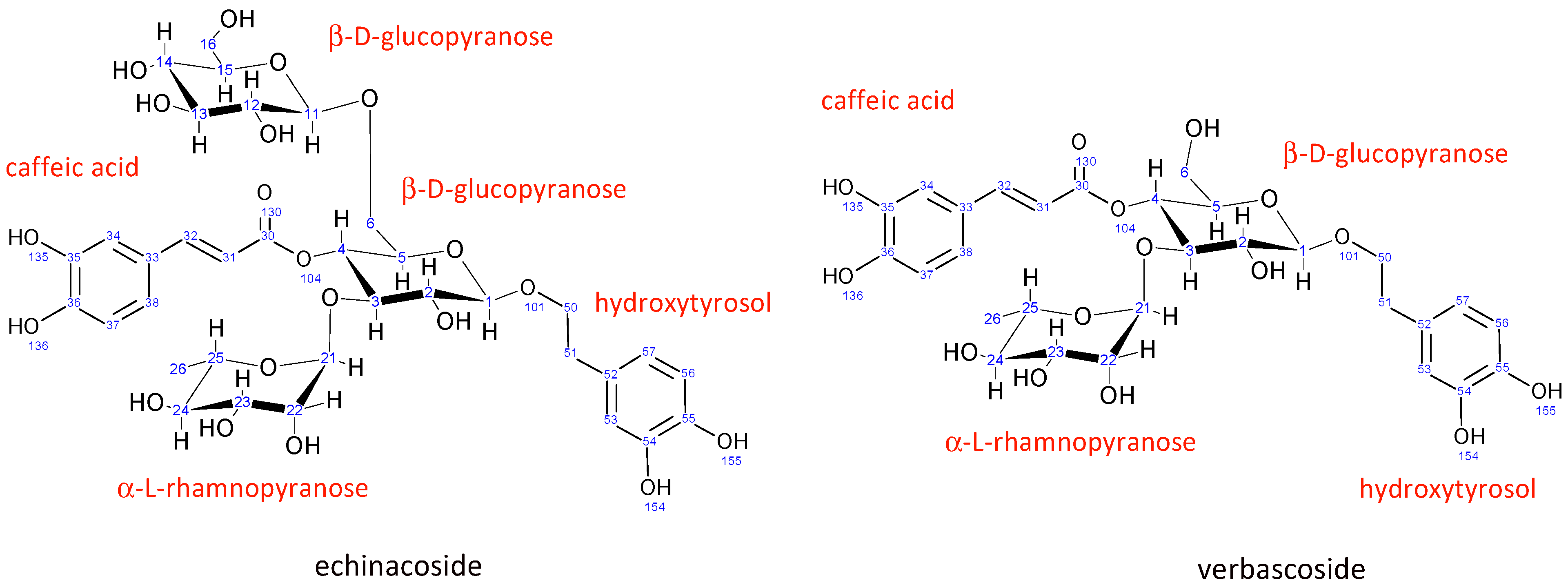
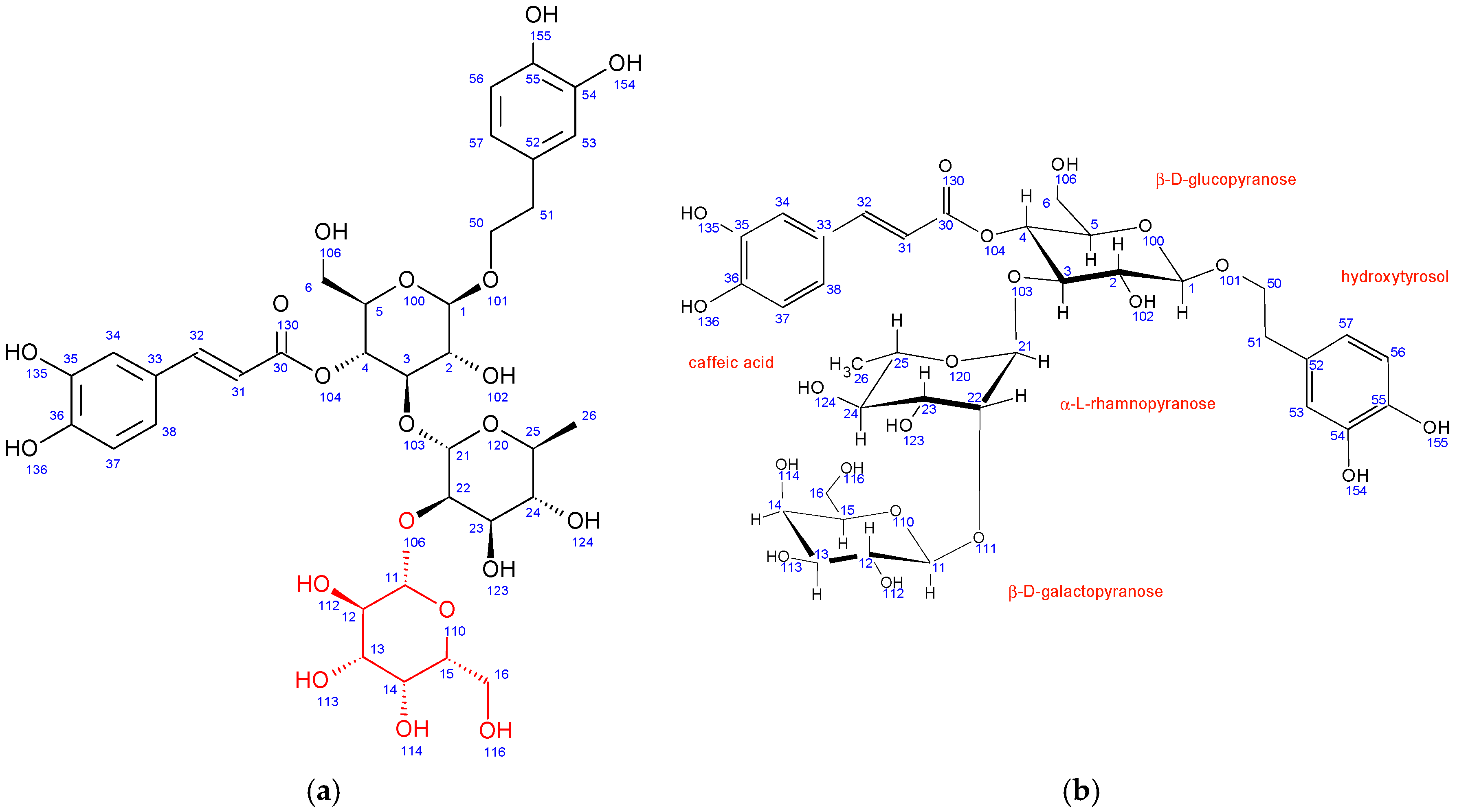

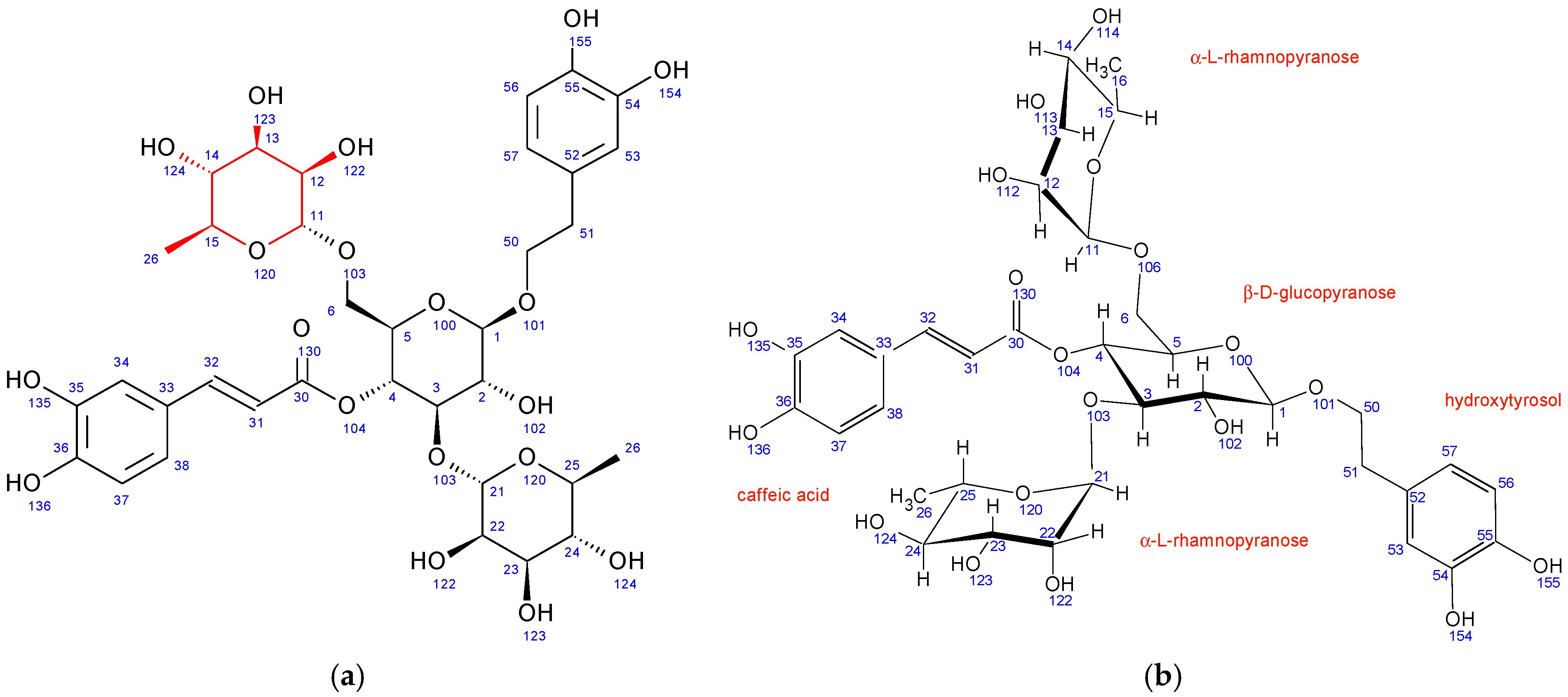

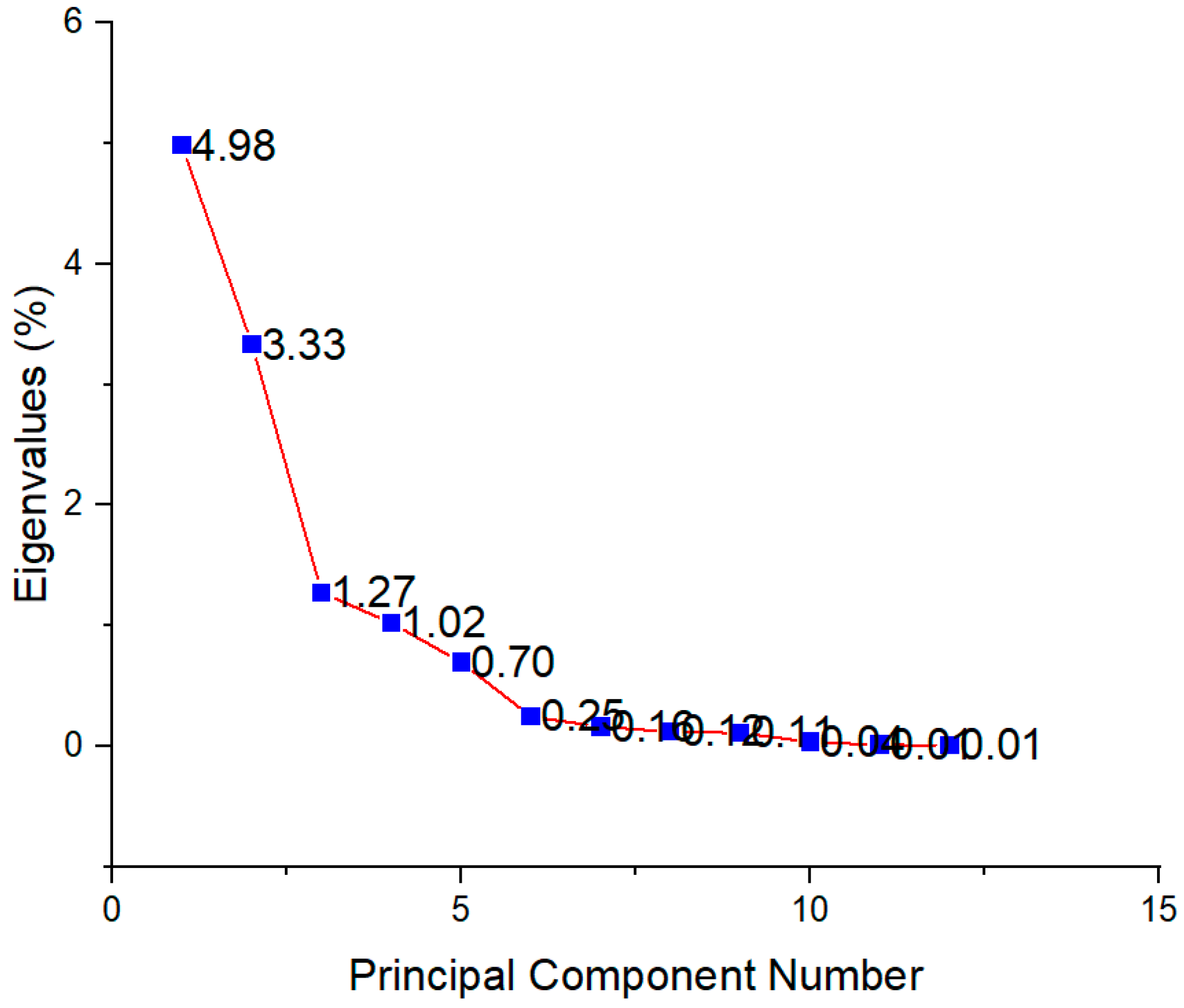
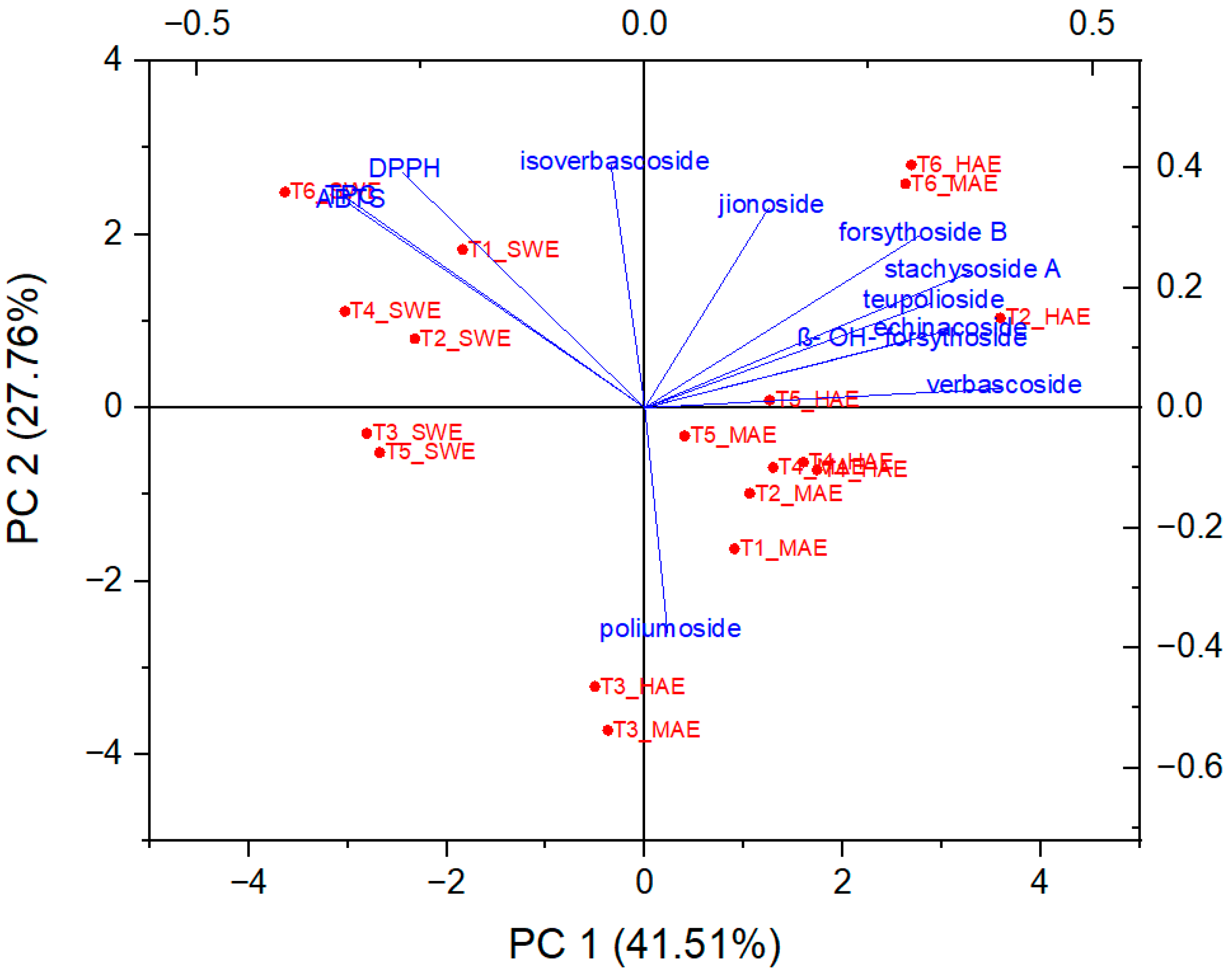

| Extraction Technique | Sample | TPC (mg eq GA g−1 dw *) | ABTS (mmol eq Trolox g−1 dw **) | DPPH (mmol eq Trolox g−1 dw **) |
|---|---|---|---|---|
| HAE | T1 | 50.10 ± 0.06 a | 0.233 ± 0.00 a | 0.209 ± 0.00 a |
| MAE | 46.52 ± 0.74 b | 0.206 ± 0.00 b | 0.171 ± 0.00 a | |
| SWE | 88.55 ± 1.81 ab | 0.412 ± 0.00 ab | 0.358 ± 0.01 a | |
| HAE | T2 | 52.78 ± 1.44 a | 0.244 ± 0.01 a | 0.230 ± 0.01 a |
| MAE | 47.75 ± 1.13 b | 0.219 ± 0.00 b | 0.204 ± 0.01 b | |
| SWE | 92.36 ± 1.81 ab | 0.406 ± 0.01 ab | 0.366 ± 0.00 ab | |
| HAE | T3 | 46.16 ± 0.25 a | 0.221 ± 0.00 a | 0.209 ± 0.00 a |
| MAE | 48.26 ± 0.06 b | 0.218 ± 0.00 b | 0.211 ± 0.00 b | |
| SWE | 88.98 ± 0.17 ab | 0.402 ± 0.01 ab | 0.336 ± 0.00 ab | |
| HAE | T4 | 49.49 ± 0.78 a | 0.261 ± 0.01 a | 0.231 ± 0.01 a |
| MAE | 47.38 ± 0.82 b | 0.223 ± 0.01 a | 0.196 ± 0.00 a | |
| SWE | 96.18 ± 1.32 ab | 0.450 ± 0.01 a | 0.368 ± 0.00 a | |
| HAE | T5 | 55.14 ± 0.78 a | 0.246 ± 0.00 a | 0.292 ± 0.00 a |
| MAE | 48.29 ± 0.35 a | 0.265 ± 0.01 b | 0.317 ± 0.00 b | |
| SWE | 84.50 ± 0.33 a | 0.458 ± 0.00 ab | 0.353 ± 0.00 ab | |
| HAE | T6 | 71.60 ±1.27 a | 0.350 ± 0.01 a | 0.338 ± 0.00 a |
| MAE | 71.80 ± 0.82 b | 0.329 ± 0.01 b | 0.331 ± 0.00 b | |
| SWE | 109.55 ± 0.66 ab | 0.547 ± 0.01 ab | 0.427 ± 0.00 ab |
| HAE | MAE | SWE | |||||||||
|---|---|---|---|---|---|---|---|---|---|---|---|
| TPC | DPPH | ABTS | TPC | DPPH | ABTS | TPC | DPPH | ABTS | |||
| TPC | 1 | TPC | 1 | TPC | 1 | ||||||
| DPPH | 0.93 | 1 | DPPH | 0.70 | 1 | DPPH | 0.93 | 1 | |||
| ABTS | 0.95 | 0.85 | 1 | ABTS | 0.92 | 0.92 | 1 | ABTS | 0.80 | 0.90 | 1 |
| Reference Standard | Molecular Formula | Error (ppm) | Calculated Mass (m/z) | Observed Mass [M-H]− (m/z) | MS/MS (m/z) and Abundance of Each Fragment Ion (%) |
|---|---|---|---|---|---|
| echinacoside | C35H46O20 | 2.80 | 785.2510 | 785.2532 | MS2 [785.2510]: 623.2200 (2.7), 477.1603 (2.9), 161.0245 (100) |
| verbascoside | C29H36O15 | 2.40 | 623.1981 | 623.1996 | MS2 [623.1996]: 461.1665 (7.9), 315.1081 (2.5), 161.0248 (100) |
| mg g−1 dw * | |||||||||||||
|---|---|---|---|---|---|---|---|---|---|---|---|---|---|
| Extraction Technique | Sample | Vicenin-2 1 | β-OH-Isoforshythoside 2 | Echinacoside | Jionoside A 2 | Teupolioside 2 | Stachysoside A 2 | Poliumoside 2 | Verbascoside | Forsythoside B 2 | Isoverbascoside 3 | Diosmin 4 | Acacetin-7-O-Rutinoside 5 |
| HAE | T1 | 0.71 ± 0.03 | 0.57 ± 0.01 | 9.10 ± 0.20 a | 1.00 ± 0.04 | 4.23 ± 0.04 | 10.57 ± 0.07 a | 1.02 ± 0.02 | 4.42 ± 0.07 ab | 2.51 ± 0.07 | / | 0.45 ± 0.04 | 0.40 ± 0.01 |
| MAE | 0.69 ± 0.04 | 0.78 ± 0.05 | 6.33 ± 0.41 a | 1.09 ± 0.03 | 3.03 ± 0.17 | 5.59 ± 0.04 a | 0.78 ± 0.01 | 2.78 ± 0.01 a | 0.94 ± 0.12 | / | 0.39 ± 0.00 | 0.37 ± 0.03 | |
| SWE | / | / | 2.94 ± 0.71 a | 1.40 ± 0.55 | / | 1.06 ± 0.49 a | / | 1.61 ± 0.60 b | 2.12 ± 1.34 | 2.09 ± 0.91 | / | / | |
| HAE | T2 | 0.58 ± 0.03 a | 0.85 ± 0.03 | 23.54 ± 1.10 a | 1.48 ± 0.10 | 6.93 ± 0.42 a | 13.39 ± 0.83 ab | 9.14 ± 0.39 a | 7.90 ± 0.46 a | 2.82 ± 0.33 | 2.01 ± 0.24 | 0.55 ± 0.10 | 0.37 ± 0.02 |
| MAE | 0.27 ± 0.02 a | 1.44 ± 0.09 | 11.94 ± 0.08 a | 1.48 ± 0.04 | 4.67 ± 0.04 b | 0.69 ± 0.01 a | 7.55 ± 0.24 a | 3.72 ± 0.06 a | / | 1.28 ± 0.07 | 0.38 ± 0.07 | 0.17 ± 0.01 | |
| SWE | / | / | 3.97 ± 0.11 a | 1.20 ± 0.20 | 1.22 ± 0.63 ab | 0.87 ± 0.11 b | 1.89 ± 0.08 a | 0.96 ± 0.07 a | 0.45 ± 0.09 | 1.04 ± 0.07 | 0.43 ± 0.02 | / | |
| HAE | T3 | / | / | 0.69 ± 0.05 | / | 2.08 ± 0.02 | 1.91 ± 0.06 | 21.72 ± 0.22 a | 3.13 ± 0.06 a | / | 0.83 ± 0.15 | 0.39 ± 0.01 | / |
| MAE | / | / | 1.81 ± 0.29 | / | 2.71 ± 0.06 | 1.90 ± 0.01 | 24.55 ± 0.76 a | 3.20 ± 0.09 b | / | / | 0.53 ± 0.02 | / | |
| SWE | / | / | / | / | / | 1.20 ± 0.05 | 4.33 ± 0.13 a | 1.06 ± 0.05 ab | / | 1.29 ± 0.06 | 0.33 ± 0.02 | / | |
| HAE | T4 | 0.36 ± 0.01 | 1.01 ± 0.01 a | 6.66 ± 0.08 b | 0.77 ± 0.02 | 19.56 ± 0.70 a | 8.02 ± 0.18 a | 0.63 ± 0.01 | 3.35 ± 0.08 a | 1.33 ± 0.00 | / | 0.44 ± 0.02 | / |
| MAE | 0.34 ± 0.00 | 3.08 ± 0.44 a | 5.48 ± 0.22 a | 1.75 ± 0.12 | 8.79 ± 1.51 a | 3.55 ± 0.63 a | 0.80 ± 0.01 | 1.87 ± 0.23 a | / | 0.56 ± 0.09 | 0.53 ± 0.10 | / | |
| SWE | / | / | 1.95 ± 0.03 ab | 1.35 ± 0.06 | / | / | / | / | / | 1.32 ± 0.08 | 0.61 ± 0.02 | / | |
| HAE | T5 | 0.57 ± 0.02 a | 0.61 ± 0.28 | 8.90 ± 0.22 b | 0.83 ± 0.06 | 4.60 ± 0.12 | 8.89 ± 0.13 a | 0.59 ± 0.01 | 6.28 ± 0.10 a | 1.58 ± 0.03 | 1.09 ± 0.05 | 0.37 ± 0.07 | 0.15 ± 0.02 |
| MAE | 0.70 ± 0.00 a | / | 9.43 ± 0.06 a | 1.19 ± 0.02 | 3.49 ± 0.02 | 5.26 ± 0.15 a | 0.74 ± 0.03 | 4.31 ± 0.07 a | 0.94 ± 0.01 | 0.55 ± 0.01 | 0.42 ± 0.08 | 0.16 ± 0.00 | |
| SWE | / | / | 2.94 ± 0.27 ab | / | / | / | / | 1.84 ± 0.05 a | / | / | / | 0.27 ± 0.11 | |
| HAE | T6 | 0.70 ± 0.01 | 1.43 ± 0.01 a | 8.57 ± 0.21 b | 0.97 ± 0.03 | 21.02 ± 0.86 a | 21.33 ± 0.78 a | 1.06 ± 0.03 | 6.00 ± 0.19 | 3.66 ± 0.05 | 1.84 ± 0.06 | 0.45 ± 0.03 | 0.46 ± 0.02 |
| MAE | 0.75 ± 0.01 | 2.66 ± 0.01 a | 8.78 ± 0.00 a | 1.72 ± 0.11 | 17.39 ± 0.04 a | 17.55 ± 0.17 a | 1.20 ± 0.19 | 5.50 ± 0.20 | 2.61 ± 0.10 | 1.47 ± 0.16 | 0.58 ± 0.01 | 0.54 ± 0.00 | |
| SWE | / | / | 3.10 ± 0.91 ab | 1.44 ± 0.70 | 1.28 ± 0.76 a | / | / | / | / | 2.16 ± 1.10 | 0.66 ± 0.26 | / | |
Disclaimer/Publisher’s Note: The statements, opinions and data contained in all publications are solely those of the individual author(s) and contributor(s) and not of MDPI and/or the editor(s). MDPI and/or the editor(s) disclaim responsibility for any injury to people or property resulting from any ideas, methods, instructions or products referred to in the content. |
© 2023 by the authors. Licensee MDPI, Basel, Switzerland. This article is an open access article distributed under the terms and conditions of the Creative Commons Attribution (CC BY) license (https://creativecommons.org/licenses/by/4.0/).
Share and Cite
Mandura Jarić, A.; Čikoš, A.; Pocrnić, M.; Aladić, K.; Jokić, S.; Šeremet, D.; Vojvodić Cebin, A.; Komes, D. Teucrium montanum L.—Unrecognized Source of Phenylethanoid Glycosides: Green Extraction Approach and Elucidation of Phenolic Compounds via NMR and UHPLC-HR MS/MS. Antioxidants 2023, 12, 1903. https://doi.org/10.3390/antiox12111903
Mandura Jarić A, Čikoš A, Pocrnić M, Aladić K, Jokić S, Šeremet D, Vojvodić Cebin A, Komes D. Teucrium montanum L.—Unrecognized Source of Phenylethanoid Glycosides: Green Extraction Approach and Elucidation of Phenolic Compounds via NMR and UHPLC-HR MS/MS. Antioxidants. 2023; 12(11):1903. https://doi.org/10.3390/antiox12111903
Chicago/Turabian StyleMandura Jarić, Ana, Ana Čikoš, Marijana Pocrnić, Krunoslav Aladić, Stela Jokić, Danijela Šeremet, Aleksandra Vojvodić Cebin, and Draženka Komes. 2023. "Teucrium montanum L.—Unrecognized Source of Phenylethanoid Glycosides: Green Extraction Approach and Elucidation of Phenolic Compounds via NMR and UHPLC-HR MS/MS" Antioxidants 12, no. 11: 1903. https://doi.org/10.3390/antiox12111903
APA StyleMandura Jarić, A., Čikoš, A., Pocrnić, M., Aladić, K., Jokić, S., Šeremet, D., Vojvodić Cebin, A., & Komes, D. (2023). Teucrium montanum L.—Unrecognized Source of Phenylethanoid Glycosides: Green Extraction Approach and Elucidation of Phenolic Compounds via NMR and UHPLC-HR MS/MS. Antioxidants, 12(11), 1903. https://doi.org/10.3390/antiox12111903








